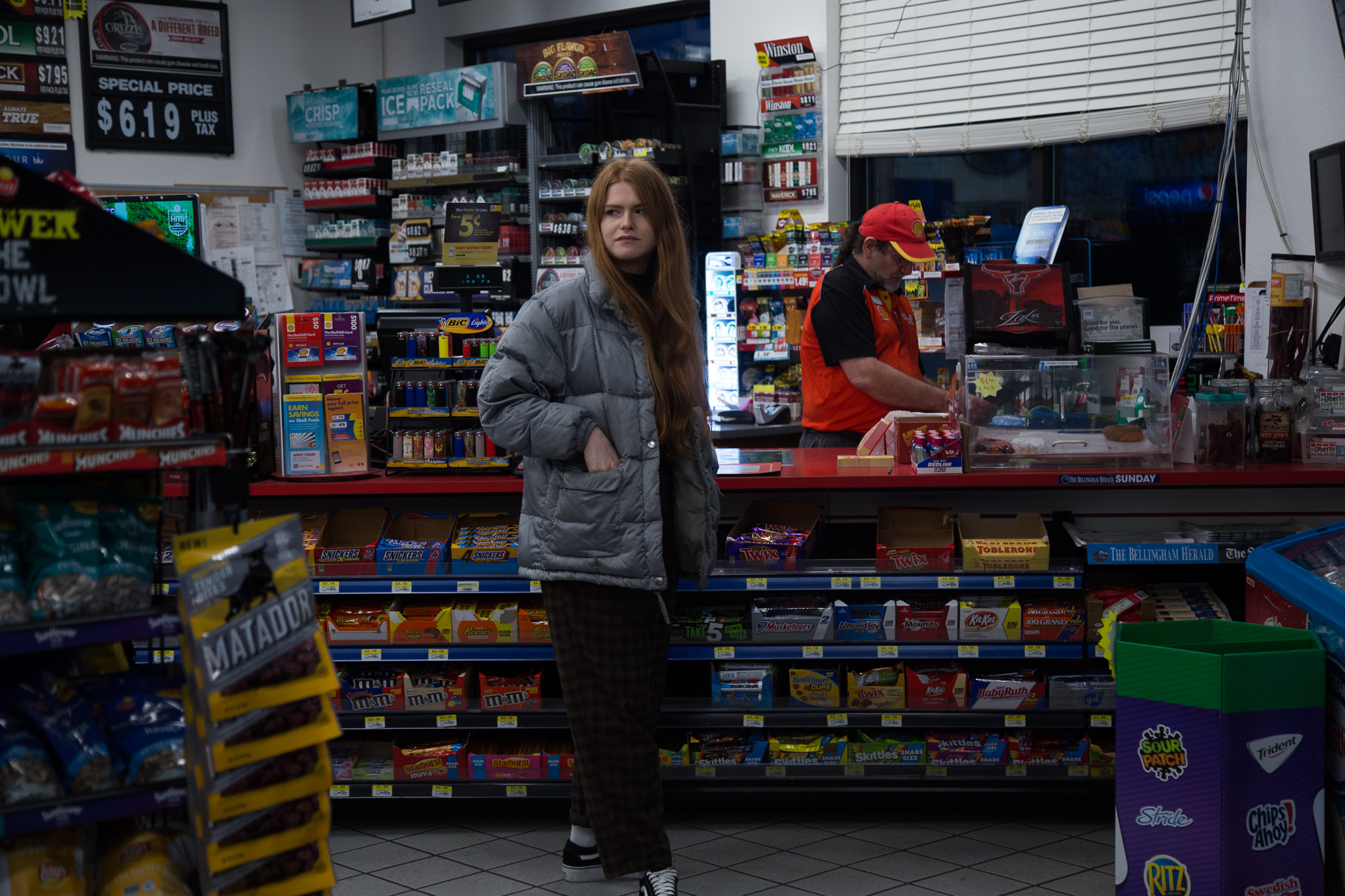Chances are, if you’ve seen someone between the ages of 14 and 20 sucking on a fourth-generation iPod shuffle on your Instagram or on the subway or on the street, then you’ve witnessed the new chic obsession for tweens and teens alike—the JUUL—aka this cool new vape thing that's not quite legal in Canada.
JUULs lie somewhere in between play-puffing on those sweet candy sticks that we used to pretend were cigarettes when we were eight and stealing dad’s Marlboro Reds when we were 14. It’s kinda like smoking but it’s not, and it tastes like mango. Instead of passing round a spliff or baggies of plant fertiliser in bathrooms at parties, kids now are trading hits on each others’ JUULs—and something about that doesn't sit well with me.
JUULs are not as deadly as cigarettes, and yet somehow this lack of danger doesn’t render them lame. Well, at least not to kids in North America, where even the New York Times has declared them a trend. The vapedemic has hit Vancouver in full force with kids here desperate to get their hands on these rad little smoke sticks. If you go to Bar None, Twelve West or Republic (literally why though?) then you’ll see these smoking playthings being passed around the dance floor like someone more retro might pass around cocaine. To “take a hit of a JUUL” is all these kids are looking for on a night out now—just a little head-rush, and that’s quite sweet really.

But due to strict vape laws in BC, these e-cigs/pacifiers are nowhere to be found in any Canadian city as they’re seen to be too appealing to young children and might be a gateway to actual smoking. Rather than a deterrent, this has added appeal because somehow it makes it more risqué. All the kids want them, so what does that mean? It means over the last few months a JUUL smuggling ring has developed across the west coast of North America with regular JUUL pickups organised monthly. These baby Pablo Escobars are crossing the border into Washington state, picking up thousands of dollars worth of JUULs and smuggling them back over—all for that delish cucumber-flavoured air.
The main question I’m left with is why—how much can someone really love an e-cig that looks like a thumb drive? Blowing billowing clouds like a dragon might be entertaining the first few times you do it, but after that I’m just not sure I get the appeal. In order to see what all the fuss is about, I asked around to identify the big dog of the JUUL smuggling world and accompany them on one of their stateside pick-ups to get the inside on why oh why these JUULs are such a hot trend. I approached the bougiest kids I could find and apparently hit the jackpot. Was I about to get detained and arrested at the border for smuggling drugs/not drugs? Who knows.

On a rainy Monday at around 4 PM we were picked up in a black Honda Civic blasting Kygo with two glam 20-year-olds in the front seat: Tara and Tara’s friend (not their real names). Inside the car was a misty minty haze as they took hit after hit on their JUULs. At first I just sat there in this hotboxed car breathing in delightfully smelling vape juice, mainly confused about what was going on. “It’s an hour and a half to the border,” Tara told us as we drove off. “We’re picking up a lot.” “Is it safe?” I asked. “Totally, I don’t know anyone who’s ever been searched.” “Also I only have a new driver’s license,” she added as we were speeding down the highway, “hope that’s cool.” Woah, she was certainly playing a dangerous game. “If I get a ticket it's literally no big deal I just have to go to court.” That kinda sounded like a big deal to me but clearly I had stepped into a car with two thrill-seekers. I guess that’s what happens when you’re nailing 0.7 ml of nicotine all day every day.
I asked them both: what is so special about a JUUL? “They’re seen as cool. Whenever we go out people will be like, ‘Yo where’s your JUUL?’ That’s the first thing people say to us,” said Tara as she offered me hers. “I got kicked out of a club last week. He was like ‘you can’t vape inside’ and I was like ‘Hun, its a JUUL, I was JUULing not vaping’ and he let me back in.” These kids clearly have all the answers.

At this point I was encouraged to take a “hit.” The best way to describe it is just sucking in a bit of minty vapour and blowing it out again. I repeated to see if I had been missing something but that was it. “What makes them different from other vapes?” I asked. “Vapes are so large whereas JUULs are this tiny little thing and they’re not loud and they’re not aggressive,” said Tara’s friend. “Plus it looks more classy and it works better. You get a stronger head rush because its way higher in nicotine.” So, they’re pretty and they give you a teeny tiny buzz. Sure. If a head rush is what they’re after, I guess standing up too fast will be all the rage soon too.
“Also you can’t get it here and I think that makes it cooler,” Tara told me. So the fact that they’re contraband in BC really is what makes these kids mad for the JUULs. In that way, JUULs are like skipping curfew or Snapchatting after 10 PM—they are simply rules to be broken. Still, I see no one going mad for Orbit gum in Vancouver, and you can’t get that in BC. “They also come in yummy flavours,” added Tara’s friend. OK fine. But how much can someone really love mango?!

Clearly these clever girls had capitalised on something. It seemed like everyone they knew was smoking JUULs and going through a pack of pods every couple of weeks—the demand was high. “At least one person goes to pick up once every month,” Tara said. “Three of us have gone this month already… We all know who has a JUUL and whenever someone is going we’ll make a huge group chat for orders.”
This is when Tara showed me her list; one on paper and one on her phone. She had at least 10 people’s orders and more were being messaged in via Snapchat and Instagram. “Does it not feel risky?” I asked. “Not really. If you’re doing the runs all the time you have to have a reason for going otherwise they’re going to get suspicious, but I have a reason to be crossing the border because I have a beach house in the states—so it’s fine.” “So is that our reason for crossing today?” I asked, wanting to make sure I was clued in ahead of the intense questioning I predicted would ensue at border control. “No, we’re saying we’re going shopping for Coachella,” answered her friend. “Which is kinda true,” she added. Of course it is.
That sweet 0.7ml of nicotine was coursing through my veins by this point and I was slamming the JUUL like no tomorrow—clearly this is why the kids can’t stop. One JUUL pod is estimated to be the equivalent in nicotine as an entire pack of cigarettes, and Tara says she goes through one pod every few days—that’s a lot of nicotine. My photographer still hadn’t tried a hit of the JUUL. Turns out she was terrified we were going to get breathalysed at the border—I don’t even know if this minty nicotine air would show up as anything but she was having none of it—bless her. She was missing out on some sweeeeet head rushes tbh.

“So who brought JUULs to Vancouver?” I asked. “My little sister discovered it, she’s 17,” said Tara’s friend. “This guy came back from California with a JUUL, and he brought it to school and everyone wanted to hit it but he wouldn't let anyone hit it. So then everyone got really mad so they made their parents take them across the border to buy a JUUL.” This doesn't scream cool to me, but what do I know. “And Bella Hadid has one,” said Tara. “They’re really big in LA.”
Feeling sufficiently educated, we arrived at the border and like a pro Tara announced us and our shopping trip. We were waved through without a second glance. Do I look basic enough to be going to Coachella? I guess so.
Turns out the main pickup of this secret smooth-running operation happens at a gas station. Tara whipped out her extensive list as we approached the counter and started listing flavours and pods. “This is gonna max out my credit card,” she said as she turned to me. This was a an extremely large amount of stuff for one person to be buying. She racked up close to US$1,000 worth of JUUL products.
In this small convenience store, Tara and her glam red designer puffer and $1,500 purse stood out like a sore thumb. Especially as her eight-minute encounter with the man at the front desk meant that a long line had built up behind her. “Twelve mint, 12 mango, six creme brûlée” (ew creme brûlée) the list went on and on and on. The man behind the counter was exasperated handing them over and even lamented that she was too slow. After eight minutes, we were done. That was pretty easy. And did I almost buy myself a JUUL? No comment.

As we got the JUULs back to the car we loaded them all into the front seat. “Where do we hide them?” I asked. The JUULs weren’t particularly bulky: their packaging was like a mix between Apple products and something from the homeware section of Urban Outfitters, so minimalist and clean. But even with such svelte millennial casing, en masse they made for quite the hefty pile. “We have to take them all out of their packets,” she said, “in case we get searched at the border, they have no proof we bought them.” Damn. This was quite the system. As we diligently unwrapped each JUUL and pack of pods, Tara labelled every one so she knew she had everyone’s orders covered. “Done?” I asked as we put the last labelled pod and JUUL into the glovebox. “Done,” she said, sucking on hers. “Who wants kombucha?” she asked. And I did, not gonna lie.
Luckily we had to hang around Washington for a couple of hours so as to make our “shopping for Coachella” story a little more believable. Bellingham is quite nice actually, and has a spattering of edgy coffee shops and vegan spots—if they’ve found themselves inadvertently become a major spot on this ever-so-bougie JUUL smuggling ring, they must have to cater for rich tweens. After a little pit stop we jumped back into the Honda, whacked on some Cardi B and drove north to the border.
This was my chance to ask a little bit more about what we should expect trying to get through. “None of us have ever got searched,” Tara reassured me. So in that vein we brazenly stuffed all the $1,000 worth of JUULs into the glove box. “Won’t this be the first place they look?” I asked Tara, starting to get a little sketched. She didn't seem phased. “Maybe, it’s highly unlikely,” she said casually. But I wondered at this point if the story would be different if we weren’t a car of white, seemingly wealthy females?

It was all fun and games until we approached border control. I’m gonna be honest with you: I was feeling a little tense. “What do I do?” I asked. “Just act casual,” Tara told me. Clearly I had no idea what that meant. Our stash was unprotected so I put my elbow on the glove box as if by casually leaning on it there couldn't possibly be $1,000 worth of contraband inside. Leaning. Just leaning. Casually. As we got closer I started to get a little angsty, like I had too many limbs and I didn't know what to do with them all. Whilst one elbow leaned on the glove box the other sat in my lap—my lap?! What do I do with my second hand?! But it was too late for a existential hand crisis, we had arrived at border control. Before I could figure out if my second hand was appropriately positioned, Tara was speaking to the lady in the kiosk.
“What did you ladies get up to this evening?” she asked. I let Tara take this one, mainly because I had seemingly forgotten all words and was totally preoccupied with all the leaning. She must be a pro by now, but even as she started listing all the possible activities we were doing stateside I sensed even this JUUL heist veteran might be a little nervous. “We went shopping but we didn't find anything,” she said. OK. That’s OK, I thought. Surely that will do. “Then we went for dinner,” she said. That’s enough Tara, you don't want to overshare. I could feel my lean becoming more agitated as she kept talking. I was bearing a lot of weight on the glove box now. “Any tobacco or alcohol in the car?” the lady in the kiosk interrupted Tara. “No,” said Tara, smiling.
I chose this moment lean forward and wave from my seat. I guess that’s what I decided to do with my second hand. I found it. In my lap. And I waved. “Just these Funyuns,” I said. There was a pause. This was horrible. “Alright ladies, have a good one.” Oh Jesus Christ! We slowly drove away. “My heart is beating so fast right now,” said Tara. What a thrill! Once in Canada, our extensive stash was safe. Another successful trip for Tara and my first illegal drug run ticked off my list. And now I can safely say I know for sure I would be a truly terrible drug mule. But it doesn't matter now, we had done it. “But why did you declare the Funyuns?!” asked my photographer as we were plain sailing down the highway. I didn’t have an answer for her. And I still don't know.
Well what an adventure and what did I learn? Well in short, lots; I learned that I’m terrible under pressure, I learned that a constant inhaling of 0.7 mls of nicotine in the space of three hours will give me the shakes, and I learned that saying ‘no’ to teenagers is enough of a reason for something to become the height of cool. Teens of my generation went after hard drugs and sketchy things that will probably kill us one day, but teens now are innocently sucking on sticks that are actively designed to stop you smoking—and good for them.
So next time you catch a youngun pounding fruity smelly mist in the street from an iPod nano style vape—just know that it probably made its journey here in the glovebox of a bougie teenager’s parent’s Honda civic. And what a journey it was.
Sign up for the VICE Canada Newsletter to get the best of VICE Canada delivered to your inbox daily.






















